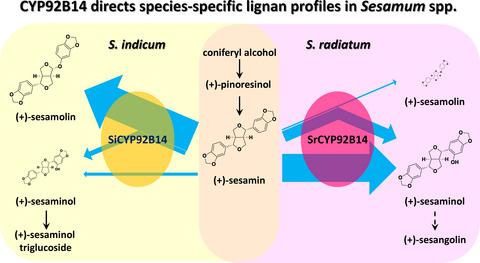Our official English website, www.x-mol.net, welcomes your
feedback! (Note: you will need to create a separate account there.)
(+)-Sesamin-oxidising CYP92B14 shapes specialised lignan metabolism in sesame.
The Plant Journal ( IF 6.2 ) Pub Date : 2020-09-21 , DOI: 10.1111/tpj.14989 Erisa Harada 1 , Jun Murata 1 , Eiichiro Ono 2 , Hiromi Toyonaga 2 , Akira Shiraishi 1 , Kosuke Hideshima 3 , Masayuki P Yamamoto 4 , Manabu Horikawa 1
The Plant Journal ( IF 6.2 ) Pub Date : 2020-09-21 , DOI: 10.1111/tpj.14989 Erisa Harada 1 , Jun Murata 1 , Eiichiro Ono 2 , Hiromi Toyonaga 2 , Akira Shiraishi 1 , Kosuke Hideshima 3 , Masayuki P Yamamoto 4 , Manabu Horikawa 1
Affiliation

|
Sesamum spp. (sesame) are known to accumulate a variety of lignans in a lineage‐specific manner. In cultivated sesame (Sesamum indicum), (+)‐sesamin, (+)‐sesamolin and (+)‐sesaminol triglucoside are the three major lignans found richly in the seeds. A recent study demonstrated that SiCYP92B14 is a pivotal enzyme that allocates the substrate (+)‐sesamin to two products, (+)‐sesamolin and (+)‐sesaminol, through multiple reaction schemes including oxidative rearrangement of α‐oxy‐substituted aryl groups (ORA). In contrast, it remains unclear whether (+)‐sesamin in wild sesame undergoes oxidation reactions as in S. indicum and how, if at all, the ratio of the co‐products is tailored at the molecular level. Here, we functionally characterised SrCYP92B14 as a SiCYP92B14 orthologue from a wild sesame, Sesamum radiatum, in which we revealed accumulation of the (+)‐sesaminol derivatives (+)‐sesangolin and its novel structural isomer (+)‐7´‐episesantalin. Intriguingly, SrCYP92B14 predominantly produced (+)‐sesaminol either through ORA or direct oxidation on the aromatic ring, while a relatively low but detectable level of (+)‐sesamolin was produced. Amino acid substitution analysis suggested that residues in the putative distal helix and the neighbouring heme propionate of CYP92B14 affect the ratios of its co‐products. These data collectively show that the bimodal oxidation mechanism of (+)‐sesamin might be widespread across Sesamum spp., and that CYP92B14 is likely to be a key enzyme in shaping the ratio of (+)‐sesaminol‐ and (+)‐sesamolin‐derived lignans from the biochemical and evolutionary perspectives.
中文翻译:

(+)-芝麻素氧化CYP92B14塑造芝麻中特化的木脂素代谢。
芝麻属。已知(芝麻)会以谱系特定的方式积聚各种木脂素。在栽培芝麻中(Sesamum indicum),(+)-芝麻素,(+)-芝麻素和(+)-芝麻素三糖苷是在种子中富含的三种主要木脂素。一项最新研究表明,SiCYP92B14是一种关键酶,可通过多种反应方案(包括α-氧基取代的芳基的氧化重排)将底物(+)-芝麻素分配给两种产物(+)-芝麻素和(+)-芝麻素。 (ORA)。相比之下,目前尚不清楚野生芝麻中的(+)-芝麻素是否会像印度线虫一样发生氧化反应。以及如何在分子水平上定制副产物的比例。在这里,我们从野生芝麻(Sesamum radiatum)的功能上将SrCYP92B14表征为SiCYP92B14直向同源物,其中我们揭示了(+)-芝麻素衍生物(+)-芝麻酚和其新型结构异构体(+)-7'-表芝麻三醇的积累。有趣的是,SrCYP92B14主要通过ORA或在芳环上直接氧化生成(+)-芝麻素,而生成的相对较低但可检测的(+)-芝麻素含量。氨基酸取代分析表明,CYP92B14的假定远端螺旋和邻近的丙酸血红素中的残基影响其副产物的比率。这些数据共同表明(+)-芝麻素的双峰氧化机制可能在从生化和进化的角度来看,芝麻属植物,而CYP92B14可能是影响(+)-芝麻素和(+)-芝麻素的木脂素比例的关键酶。
更新日期:2020-11-21
中文翻译:

(+)-芝麻素氧化CYP92B14塑造芝麻中特化的木脂素代谢。
芝麻属。已知(芝麻)会以谱系特定的方式积聚各种木脂素。在栽培芝麻中(Sesamum indicum),(+)-芝麻素,(+)-芝麻素和(+)-芝麻素三糖苷是在种子中富含的三种主要木脂素。一项最新研究表明,SiCYP92B14是一种关键酶,可通过多种反应方案(包括α-氧基取代的芳基的氧化重排)将底物(+)-芝麻素分配给两种产物(+)-芝麻素和(+)-芝麻素。 (ORA)。相比之下,目前尚不清楚野生芝麻中的(+)-芝麻素是否会像印度线虫一样发生氧化反应。以及如何在分子水平上定制副产物的比例。在这里,我们从野生芝麻(Sesamum radiatum)的功能上将SrCYP92B14表征为SiCYP92B14直向同源物,其中我们揭示了(+)-芝麻素衍生物(+)-芝麻酚和其新型结构异构体(+)-7'-表芝麻三醇的积累。有趣的是,SrCYP92B14主要通过ORA或在芳环上直接氧化生成(+)-芝麻素,而生成的相对较低但可检测的(+)-芝麻素含量。氨基酸取代分析表明,CYP92B14的假定远端螺旋和邻近的丙酸血红素中的残基影响其副产物的比率。这些数据共同表明(+)-芝麻素的双峰氧化机制可能在从生化和进化的角度来看,芝麻属植物,而CYP92B14可能是影响(+)-芝麻素和(+)-芝麻素的木脂素比例的关键酶。











































 京公网安备 11010802027423号
京公网安备 11010802027423号